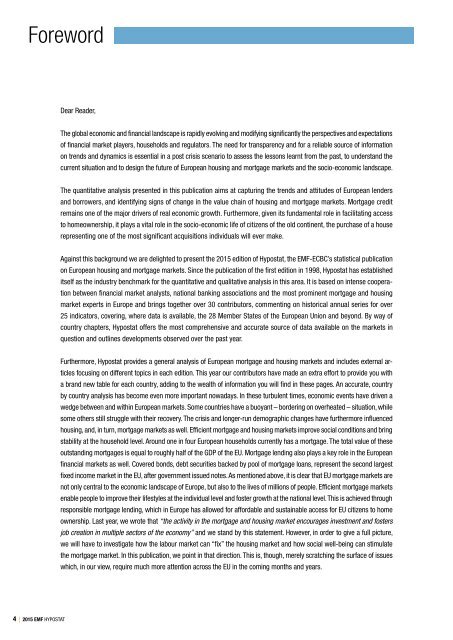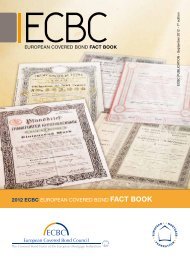Hypostat 2015
On 30 September 2015, the EMF-ECBC published Hypostat 2015 , which is its main statistical report, encompassing data on recent developments in housing and mortgage markets in the EU28 and beyond. Hypostat is the result of a collaborative effort by the European Mortgage Federation’s national delegations and external experts. The publication covers 33 countries – i.e. the EU28 plus Iceland, Norway, Russia, Turkey and the United States.
On 30 September 2015, the EMF-ECBC published Hypostat 2015 , which is its main statistical report, encompassing data on recent developments in housing and mortgage markets in the EU28 and beyond. Hypostat is the result of a collaborative effort by the European Mortgage Federation’s national delegations and external experts.
The publication covers 33 countries – i.e. the EU28 plus Iceland, Norway, Russia, Turkey and the United States.
You also want an ePaper? Increase the reach of your titles
YUMPU automatically turns print PDFs into web optimized ePapers that Google loves.
Foreword<br />
Dear Reader,<br />
The global economic and financial landscape is rapidly evolving and modifying significantly the perspectives and expectations<br />
of financial market players, households and regulators. The need for transparency and for a reliable source of information<br />
on trends and dynamics is essential in a post crisis scenario to assess the lessons learnt from the past, to understand the<br />
current situation and to design the future of European housing and mortgage markets and the socio-economic landscape.<br />
The quantitative analysis presented in this publication aims at capturing the trends and attitudes of European lenders<br />
and borrowers, and identifying signs of change in the value chain of housing and mortgage markets. Mortgage credit<br />
remains one of the major drivers of real economic growth. Furthermore, given its fundamental role in facilitating access<br />
to homeownership, it plays a vital role in the socio-economic life of citizens of the old continent, the purchase of a house<br />
representing one of the most significant acquisitions individuals will ever make.<br />
Against this background we are delighted to present the <strong>2015</strong> edition of <strong>Hypostat</strong>, the EMF-ECBC’s statistical publication<br />
on European housing and mortgage markets. Since the publication of the first edition in 1998, <strong>Hypostat</strong> has established<br />
itself as the industry benchmark for the quantitative and qualitative analysis in this area. It is based on intense cooperation<br />
between financial market analysts, national banking associations and the most prominent mortgage and housing<br />
market experts in Europe and brings together over 30 contributors, commenting on historical annual series for over<br />
25 indicators, covering, where data is available, the 28 Member States of the European Union and beyond. By way of<br />
country chapters, <strong>Hypostat</strong> offers the most comprehensive and accurate source of data available on the markets in<br />
question and outlines developments observed over the past year.<br />
Furthermore, <strong>Hypostat</strong> provides a general analysis of European mortgage and housing markets and includes external articles<br />
focusing on different topics in each edition. This year our contributors have made an extra effort to provide you with<br />
a brand new table for each country, adding to the wealth of information you will find in these pages. An accurate, country<br />
by country analysis has become even more important nowadays. In these turbulent times, economic events have driven a<br />
wedge between and within European markets. Some countries have a buoyant – bordering on overheated – situation, while<br />
some others still struggle with their recovery. The crisis and longer-run demographic changes have furthermore influenced<br />
housing, and, in turn, mortgage markets as well. Efficient mortgage and housing markets improve social conditions and bring<br />
stability at the household level. Around one in four European households currently has a mortgage. The total value of these<br />
outstanding mortgages is equal to roughly half of the GDP of the EU. Mortgage lending also plays a key role in the European<br />
financial markets as well. Covered bonds, debt securities backed by pool of mortgage loans, represent the second largest<br />
fixed income market in the EU, after government issued notes. As mentioned above, it is clear that EU mortgage markets are<br />
not only central to the economic landscape of Europe, but also to the lives of millions of people. Efficient mortgage markets<br />
enable people to improve their lifestyles at the individual level and foster growth at the national level. This is achieved through<br />
responsible mortgage lending, which in Europe has allowed for affordable and sustainable access for EU citizens to home<br />
ownership. Last year, we wrote that “the activity in the mortgage and housing market encourages investment and fosters<br />
job creation in multiple sectors of the economy” and we stand by this statement. However, in order to give a full picture,<br />
we will have to investigate how the labour market can “fix” the housing market and how social well-being can stimulate<br />
the mortgage market. In this publication, we point in that direction. This is, though, merely scratching the surface of issues<br />
which, in our view, require much more attention across the EU in the coming months and years.<br />
4 | <strong>2015</strong> EMF HYPOSTAT



